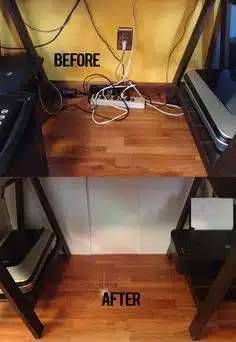To baby-proof cords, install outlet covers, cord shorteners, and cable tubes to prevent access. Keep cords hidden or high.
Baby-proofing cords involves ensuring electrical cables are secured and out of reach to prevent strangulation or injury. Implementing outlet caps, covers, and cord shorteners can increase safety and minimize hazards in your home. By following these simple steps, you can create a safer environment for your baby while reducing the risk of electrical accidents.
Don’t forget to regularly inspect and maintain these safety measures to ensure ongoing protection for your little one.

Credit: www.reddit.com
Understanding Babyproofing Cords
To babyproof cords, hide them behind furniture or under rugs, unplug unnecessary items, and tie up or cover electrical cables. Install outlet covers and use cord shorteners or covers for exposed cords. Consider extending outlets using raceways for a clean and organized solution.
Importance Of Babyproofing
It is crucial to babyproof cords to ensure the safety of your little ones. Wires and cords can pose serious hazards, including strangulation, electric shocks, and tripping. Therefore, it is essential to take measures to secure and protect cords within your home.Common Risks Associated
The common risks associated with unsecured cords include strangulation and choking hazards, electrical injuries, and tripping accidents. Uncovered cords can also entice curious babies and become a potential source of danger if not properly managed. In order to prevent these risks, it’s important to use products such as outlet covers, cord shorteners, and cable tubes to ensure your child’s safety around cords and electrical outlets. Regularly inspecting and addressing any cord-related hazards is also essential to create a safe environment for your little one. As a parent, taking proactive measures to babyproof your home will help create a secure environment and minimize potential accidents.Babyproofing Techniques
To baby proof cords, install plug-in outlet covers, cord shorteners, and conceal angles with snap-on corners. Ensure cords are hidden behind furniture or under rugs to prevent children from playing with them. Unplug unnecessary items when not in use and secure electrical wires high out of reach.
Outlet Covers
Installing outlet covers is a crucial step in babyproofing your home to prevent accidents.
Cord Shorteners
Using cord shorteners helps to reduce excess cord length, keeping them out of reach of curious hands.
Cord Covers For The Floor
Investing in cord covers for the floor is an effective way to prevent tripping hazards and protect cords.
Common Mistakes To Avoid
Babyproofing your home is crucial to ensure the safety of your little one. One area that requires special attention is cords. It’s important to babyproof cords to prevent accidents and potential dangers. However, there are some common mistakes that parents make when it comes to babyproofing cords. In this section, we will discuss these mistakes and how to avoid them.
Using Improper Materials
One of the common mistakes parents make when babyproofing cords is using improper materials. It’s important to use the right materials that are specifically designed for babyproofing purposes. Avoid using random items like tape or string to secure cords, as they can easily come loose and pose a choking hazard for your baby. Instead, opt for babyproofing products such as cord covers, cord shorteners, and outlet covers that are specifically designed to keep cords out of reach.
In summary:
- Avoid using improper materials like tape or string to secure cords
- Use babyproofing products such as cord covers and cord shorteners
- These products are specially designed for babyproofing purposes
- They ensure cords are safely secured and out of your baby’s reach
Not Securing Cords Properly
Another common mistake that parents make is not securing cords properly. It’s important to ensure that cords are well secured and out of your baby’s reach. This means properly installing cord covers or using cord shorteners to keep cords taut and away from your baby’s curious hands. Always double-check the tightness of the cord covers or shorteners to make sure they are secure.
In summary:
- Ensure cords are well secured and out of your baby’s reach
- Properly install cord covers or use cord shorteners
- Check the tightness of the cord covers or shorteners regularly
- Make sure they are securely keeping the cords away from your baby
By avoiding these common mistakes, you can effectively babyproof cords in your home and create a safer environment for your little one. Remember to always choose the right materials and properly secure the cords to prevent accidents and potential hazards.

Credit: www.reddit.com
Tips For Babyproofing Specific Areas
Baby’s nurseries are filled with potential hazards for curious little ones. When babyproofing cords in the nursery, it’s crucial to keep them out of reach and secure. Here are some tips:
- Use cord shorteners for long cords
- Secure cords with childproof power strips
- Hide electrical wires in child-safe cable tubes
The living room is a hub of activity where cords are abundant. To babyproof cords in this area, follow these suggestions:
- Install electrical outlet covers for exposed cords
- Consider using cord covers for the floor
- Be mindful of hiding cords behind furniture
In a home office setting, cords from electronics and devices can pose dangers to little explorers. Babyproof cords in your home office with these measures:
- Use outlet plates to cover empty outlets
- Organize and secure cords with cord management systems
- Consider using cord shorteners for tidy cord management
Practical Solutions For Concealing Cords
Babyproofing your home is crucial to ensure the safety of your little ones, and one area that requires attention is cord management. Exposed cords can pose a serious risk, as they can become a strangulation hazard or tempt curious hands to pull on them. Fortunately, there are practical solutions available to help you conceal cords and minimize these risks. In this article, we will explore three effective methods for cord management: the use of cable tubes, extension outlets, and taping down cords.
Use Of Cable Tubes
One reliable way to conceal cords is by using cable tubes. These tubes are specially designed to hold and protect your cords, keeping them out of reach from curious hands. Here’s how you can utilize cable tubes for babyproofing:
- Identify the cords that need to be concealed, such as those behind the TV or computer setup.
- Measure the length of the cords to ensure you select the appropriate size of cable tubes.
- Open the cable tube and insert the cords inside. You may need to gather the cords together using zip ties or Velcro straps to keep them organized.
- Once the cords are inside the tube, close it securely.
- Position the cable tube behind furniture or along the baseboard to keep it hidden from view.
Extension Outlets
An extension outlet can be a real game-changer when it comes to managing cords and ensuring your little one’s safety. Here’s how you can effectively use extension outlets:
- Identify the outlets where you have multiple cords plugged in.
- Purchase an extension outlet that offers multiple sockets.
- Unplug all the cords and plug them into the extension outlet instead.
- Position the extension outlet in a location where it is out of reach from your baby.
- Secure the cords using cable ties or cord clips to prevent them from hanging freely.
Taping Down Cords
Another effective method for cord management is taping down cords. This solution works well for cords that are running along the floor or carpeted surfaces. Here’s how you can safely tape down cords:
- Gather the cords together and straighten them out.
- Place adhesive cord covers or cord channels over the cords.
- Secure them to the floor using strong double-sided tape.
- Ensure that the tape is firmly pressed down to prevent it from becoming a tripping hazard.
- Avoid placing tape or cords near open flames or heat sources.
Child-friendly Cord Protectors
Baby-proofing your home includes hiding and securing electrical cords to prevent accidents. Child-friendly cord protectors are designed to keep your little ones safe from potential hazards. Let’s explore some effective solutions to safeguard your cords while keeping your home stylish and child-friendly.
Usb Charger Cover
When it comes to preventing accidents involving chargers, USB charger covers are essential. These covers are specifically designed to encase the charger and its cord, ensuring your child cannot access the electrical components. By using a USB charger cover, you can maintain a safer environment for your little one without compromising on the functionality of your devices.
Cord Protector Products
There are numerous cord protector products available in the market that offer effective solutions for securing electrical cords in your home. From cord concealers to cable tubes, these products keep cords out of reach and eliminate trip hazards. Cord protector products not only enhance the safety of your home but also contribute to a tidy and organized living space, free from potential dangers.
Expert Advice And Insights
Babyproofing your home is essential to ensure your little one’s safety. Cords pose a significant risk to babies and require thorough attention. Expert advice and insights can provide valuable tips and strategies for effectively baby-proofing cords. Let’s explore online community discussions and professional recommendations to gain useful advice for cord babyproofing.
Online Communities Discussions
- Check parenting forums for discussions on babyproofing cords
- Engage in conversations to gather insight from other parents’ experiences and solutions
- Participate in subreddits such as r/Parenting and r/NewParents for practical advice and recommendations
Professional Recommendations
- Consult child safety experts for professional assessments and guidance
- Seek advice from babyproofing specialists or consultants for personalized solutions
- Consider hiring a professional babyproofer for a thorough assessment and implementation of cord safety measures

Credit: www.pinterest.com
Frequently Asked Questions
How To Baby Proof Exposed Cords?
To baby-proof exposed cords, install plug-in outlet covers, cord shorteners, and use safety cable tubes. Hide cords behind furniture or under rugs. Always unplug when not in use, and don’t give substitutes. Consider electrical outlet caps, covers, and power strips as well as using cord covers on the floor or for long cords.
How Do I Get My Baby To Stop Playing With Cords?
To prevent your baby from playing with cords, hide them behind furniture or under rugs. Unplug unused cords and use child-safe cable tubes or secure them out of reach. Avoid giving substitutes and always supervise your baby around exposed cords.
How Do You Protect Wires From Babies?
To protect wires from babies, tie up or cover electrical cables. You can also use child-safe cable tubes or secure the wires high up out of reach. Additionally, consider installing outlet caps, plates, and covers for exposed cords. Use childproof power strips and cord covers for the floor.
How Can You Prevent A Baby From Being Hurt By Outlets And Cords?
To prevent a baby from being hurt by outlets and cords, use outlet covers, cord shorteners, and cord covers on the floor. Ensure cords are hidden or secured high up out of reach. Unplug unnecessary devices and don’t give substitutes.
Conclusion
When it comes to baby-proofing cords, safety is key. By implementing outlet covers and cord shorteners, you can create a secure environment for your little one. Remember to hide and secure cords out of reach to prevent accidents. Protect your child with these simple yet effective solutions.




